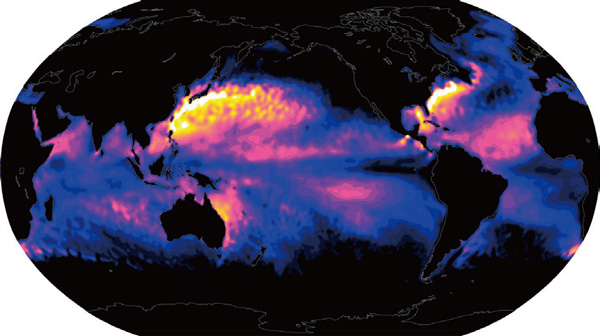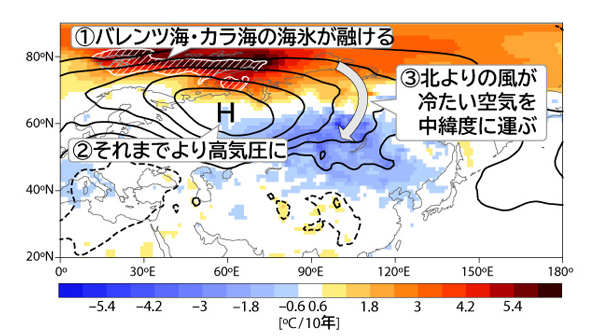Climate Science Research
Nakamura Laboratory
Understanding formation and variability of the climate system and extreme weather through big data analysis and diversified numerical simulations
Deciphering Earth's climate system from a viewpoint of ocean-atmosphere interactions
Earth's atmosphere and ocean interact mutually to form the climate system, which varies internally owing to its chaotic nature. Superimposed on the ongoing anthropogenic warming, the internal variability acts to enhance the likelihood of extreme weather events and associated natural disasters. Our research aims at deepening our understanding of the climate variability and predictability of those events, by utilizing huge “reanalysis climate data”, into which past observational data have been assimilated through a modern forecast system to reproduce the history of the evolving climatic state four-dimensionally. Numerical simulations with ocean/atmosphere models, especially with many ensemble members integrated from slightly modified initial conditions, are utilized for clarifying mixed causality behind the variability and extreme events and assessing their predictability.
Producing regional atmospheric reanalysis data
Despite the continuous production of the global atmospheric reanalysis data by the Japan Meteorological Agency (JMA), no regional atmospheric reanalysis data in operational quality are thus far available for Japan. Under the funding by the Japan Agency for Science and Technology (JST) and close collaboration with JMA and Information Technology Center (ITC) of our university, we initiated a 10-year project “ClimCORE” (Project Leader: Prof. H. Nakamura) in late 2020 to produce high-resolution atmospheric reanalysis data (RRJ-ClimCORE) over Japan and its surrounding maritime domain for broad business and community applications. Based on the latest version of the JMA meso-forecast system, the hourly RRJ-ClimCORE data will become available for the 20+ years for the current century at 5-km grid intervals. Project Associate Professer Makoto Iida, who belongs to our lab and acts as a sub-PL of ClimCORE, has his own page at the Initiatives for Global Security and Energy Transition” .

Wavy pressure anomalies caused a heat wave to Japan in August 2010

Active air-sea interaction along Kuroshio and Gulf Stream

Arctic sea ice reduction cools Asia in winter
‘Onko Chishin’—this phrase embodies our research philosophy and underscores the significance of ‘reanalysis data’ that supports it. This involves assimilating past observational data into the latest numerical weather prediction systems, creating high-quality, four-dimensional reproductions of the atmosphere and ocean states over long periods from the past to the present. By applying statistical analysis and dynamic diagnostics to this data, we first grasp the reality of atmospheric circulation variability and its interactions with the ocean. We then use numerical experiments to elucidate these mechanisms, which aids in exploring predictability and interpreting global warming simulations. The Meteorological Agency’s Panel on Extreme Climate Events, which I chair, relies heavily on global atmospheric reanalysis data. However, for analyzing recent extreme weather phenomena such as heatwaves and heavy rains exacerbated by global warming, high-resolution reanalysis data specific to Japan is desired in addition to global reanalysis. Creating this data is the goal of the ClimCORE project. Data at a 5km horizontal resolution and hourly intervals is expected to be useful not only for understanding and mitigating regional extreme phenomena such as heatwaves and heavy rains but also in a wide range of weather-affected social fields such as renewable energy, agriculture, transportation and logistics, and insurance and finance. The use of AI is indispensable in this regard, and recently, AI-based weather forecasting has been approaching practical implementation. This is also a form of ‘Onko Chishin,’ as practical A I forecasting depends on high-quality long-term reanalysis data and analysis fields (initial values of forecasts). In other words, AI forecasting is only possible with the current weather prediction systems.Reanalysis data will become increasingly important in the future.
Member

-
- Professor
Hisashi NAKAMURA
Research Area: Dynamics for climate variability and extreme weather, Air-sea interaction - Professor

-
- Project Associate Professor
Takafumi MIYASAKA
Research Area: Climate variability, Extreme weather, Air-sea interaction - Project Associate Professor
Laboratory Homepage
Tags

